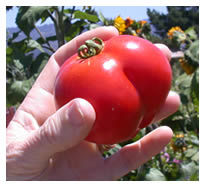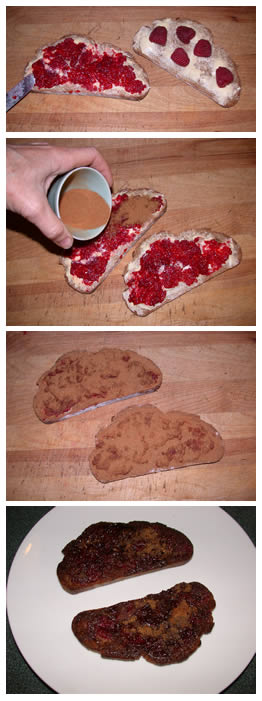Notes from Debbie's Kitchen~~~~~~~~~~~~~~~~~~~~~~~~~~~~~~~~~~~~~~~~~~~~~~~~

I hope you were all as pleasantly surprised as I was by the substitution in last week's shares: after the newsletter went out, I learned that we had sufficient tomatoes and peppers coming out of the fields and so Tom decided to put them
in the boxes instead of beets from Lakeside. The tomatoes are finally here... hooray! One member emailed me, disappointed, as she had had dinner plans, with guests, centered around the beets which were supposed to be in the box. She told me what she was making and I asked her for the recipe, because I knew we'd be having fresh, sweet beets from our apprentices' fields in the box this week. Beautiful chioggia and golden beets; both delicious and gorgeous. Enjoy!
- Debbie
. . . . . . . . . . . . . . .
The first recipe comes courtesy of member Nerija T., who says, "This 'awesome pink' cold beet soup or 'saltibatsciai' is super easy to make and delicious! It is a summer staple in Lithuania, where I am from."
Lithuanian Beet Soupquantity: Nerija says, "a group of five friends finished it all (most had seconds) ;-)"
3 medium size beets, boiled, peeled and grated (coarsely)
5-6 hard boiled eggs, chopped
3-4 cucumbers (from the box) diced
dill and scallions/chives to taste (I put LOTS of dill!)
salt & pepper to taste
1.5 quarts of kefir or buttermilk
optional: squeeze half a lemon if buttermilk is too mild
Combine all ingredients and refrigerate until totally cold. Serve cold.
Nerija also says, "I never eat this soup by itself, always with boiled (fresh) potatoes seasoned with some more dill! I also have to say that the ingredients make this meal. Last night my beets (from Whole Foods) were so-so, so the soup lacked sweetness that good beets would contribute."
Since this week's beets are a mix of chiogga and golden, I bet it would be lovely to make two separate, smaller batches with each color of beet, then serve them side by side in a bowl. If someone does this, I hope you take a picture and send it to me! (If I make it, I'll take a picture, of course.)
Probably there's no pressing need for tomato recipes just yet... if you're like me when the first precious few arrive, I just cut them and eat them with a little salt. Oh they are so good! I remember a few weeks back mentioning the spicy Mexican cucumber popsicles a friend had tried from a streetside vendor. She said they were really delicious, but didn't have a recipe, so I went online and did a little research and... voila!Cucumber-chili "paletas" (Mexican popsicles)This recipe calls for using fruit bar molds, however I'm sure you creative types out there can come up with a substitution if you don't happen to have them.
3 C 1-inch chunks peeled, seeded cucumber
2/3 C sugar
1/3 C lemon juice
1 jalapeno chili, rinsed, stemmed, coarsely chopped (remove seeds and veins for less heat)
Combine all ingredients in a blender and whirl until smooth. Push mixture through a fine strainer set over a
2-cup glass measure; discard residue.
Pour paletas mixture equally into 6 juice bar molds; attach covers. Insert sticks, leaving 1 1/2 to 2 inches of each exposed. Freeze paletas upright until firm, at least 3 hours or up to 2 weeks.
To decant, hold each mold up to the rim under warm running water just until the paletas are released from sides of molds, 5 to 15 seconds. Remove covers and pull out paletas.
Of course "paletas" come in many flavors... here's another everyone will have the ingredients for:Strawberry paletas3 3/4 C rinsed, hulled strawberries
1/3 C sugar
1 tbsp. lemon juice
Puree strawberries in a blender until smooth. Push through a fine strainer into a 2-cup glass measure; discard residue. Add sugar and lemon juice; stir until sugar is dissolved. Freeze and decant as described in recipe above.
This year we have a healthy crop of raspberries too, so for you fruit option members, here's a raspberry idea I 'cooked up' last week: Raspberry Cinnamon Toast
Raspberry Cinnamon ToastSliced bread (I used bread from my Companion Bakers bread share)
Butter
1 lightly-rounded tsp. sugar per slice of bread (I like to use organic sucanat - something I discovered recently; it is simply evaporated cane juice, and so is a lot like brown sugar, but better! But any sugar will do just fine, really.)
1/4 tsp. cinnamon per slice of bread
half a dozen raspberries per slice of bread
Spread butter evenly to edges of bread. Don't be too skimpy; you want enough butter for the sugar to melt into it and get bubbly. Smash and spread raspberries on top of the butter. In a small cup, combine cinnamon and sugar; sprinkle evenly over buttered, berried bread. Toast in a toaster oven or broiler until sugar and butter combine and bubble hotly; you want it to kind of caramelize. Be careful when removing from toaster, as it will be extremely hot! And of course allow to cool sufficiently before biting into or you'll scorch the roof of your mouth. This was delicious! The photo looks like the toast is burnt, but it is just a beautiful dark, crunchy brown caramel.
Roasted baby carrots with chile, mint, and orange glazefrom an undated Bon Appetit clipping (with the usual slight modifications)
8 servings [but you can easily halve the recipe]
1/4 C fresh orange juice
2 tbsp. olive oil, divided
1 tbsp. unseasoned rice vinegar
1/2 tsp. dried crushed red pepper
1/2 tsp. salt
4 bunches baby carrots, trimmed and peeled [just use farm carrots, peeled and cut into 'baby-carrot-sized' sticks]
2 tbsp. thinly sliced fresh mint
1 1/2 tsp. finely grated orange peel
Preheat oven to 375 degrees F. Whisk juice, 1 tbsp. oil, and vinegar in small bowl to blend; set aside.
Stir remaining 1 tbsp. oil, crushed red pepper, and salt in medium bowl. Add carrots and toss to coat. Scrape carrot mixture onto large rimmed baking sheet. Arrange carrots in single layer.
Roast carrots until almost tender, stirring occasionally, about 15 minutes (depending on size). Add juice mixture and toss to blend. Roast until juices are reduced to glaze and coat carrots, stirring occasionally, about 10 minutes longer. Season to taste with more salt, if desired. Transfer carrots to large bowl; add mint and orange peel and toss to blend. Transfer to serving bowl.
One more Bon Appetit clipping...Farro, Radicchio, and Roasted Beet Salad6 to 8 servings.
"Farro is an ancient variety of wheat with a hearty texture and nutty flavor. Here the whole grain is tossed with bitter radicchio and earthy beets for a pretty, delicious and healthful salad." (Those magazine copywriters...) ;-)
8 1- to 1 1/2-inch diameter beets, tops trimmed to 1 inch
Vegetable oil
1 1/2 C semi-pearled farro or wheat berries
4 tbsp. extra-virgin olive oil, divided
4 tbsp. red wine vinegar, divided
1 garlic clove, pressed
2 C (packed) thinly sliced quartered radicchio (from about 1 medium head)
1/2 C finely chopped red onion
1/3 C chopped fresh Italian parsley
1 C crumbled feta cheese (about 4 oz)
Preheat oven to 350 degrees F. Arrange beets in single layer in 8x8x2-inch baking dish. Drizzle with oil. Cover with foil and roast until beets are tender, about 45 minutes. [Of course there are many ways to roast beets - this is just one way.] Cool. Trim beets; peel. (Can be made a day ahead; cover and refrigerate.)
Cook farro in large saucepan of boiling salted water until tender, stirring occasionally, about 20 minutes. Drain. Transfer to large bowl. Stir 2 tbsp. olive oil, 1 tbsp. vinegar, and garlic into hot farro. Cool to room temperature
Cut each beet into 6 to 8 wedges. Add beets, radicchio, onion and parsley to farro; toss to incorporate evenly.
Whisk 2 tbsp. olive oil and 3 tbsp. vinegar in small bowl. Drizzle over salad. Add feta cheese; toss to coat.
Note: this recipe calls for 'semi-pearled farro' -- a version of the grain that doesn't require soaking before being cooked. If you're using regular farro, be sure to plan ahead. It will need to soak overnight. Farro is available at specialty food stores, natural food stores, and Italian markets.